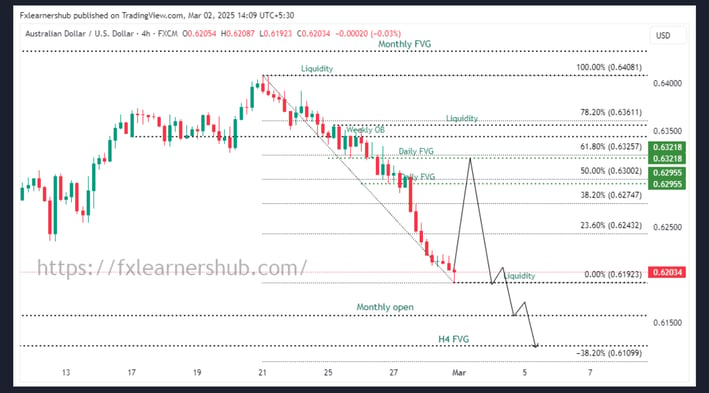AUDUSD Weekly Analysis 03/01/2025
Satheesh Gobi
3/2/2025


AUDUSD Weekly Fundamental analysis
1. Overview of Momentum and Market Structure
Current Momentum: Bearish
Previous Week’s Performance: Bearish
Range: 0.6408 – 0.6192
Expectations: Price is expected to move lower, targeting liquidity zones and fair value gaps (FVGs).
Trading Plan
For Long Positions
Strategy:
Look for buying opportunities at strong demand zones for a possible retracement:
0.6157 (Monthly Open - Key Support for Possible Bounce)
0.6126 (H4 FVG - Potential Demand & Buy Area)
Buy Targets:
0.6192 (Liquidity Pool - Short-Term Bounce Zone)
0.6295 (Daily FVG - Possible Retest Level for Shorts to Re-enter)
0.6321 (Daily FVG - Strong Resistance & Short-Term Target for Bulls)
0.6433 (Monthly FVG - Extended Target for a Reversal Setup)
Bearish Bias
Strategy:
Look for short positions at strong resistance and liquidity levels:
Sell Levels:
0.6295 (Daily FVG - Key Resistance & Institutional Sell Zone)
0.6321 (Daily FVG - Fair Value Gap for Bearish Continuation)
0.6344 (Weekly OB - Strong Order Block & Key Supply Zone)
0.6356 (H4 Liquidity - Potential Liquidity Grab & Reversal Zone)
Primary Targets:
0.6192 (Extreme Liquidity - First Take-Profit Zone for Shorts)
0.6157 (Monthly Open - Historical Support & Key Demand Area)
0.6126 (H4 FVG - Institutional Buy Zone & Potential Reversal Area)
Summary
Bearish sentiment with short setups at 0.6295, 0.6321, 0.6344, and 0.6356, targeting 0.6192, 0.6157, and 0.6126.
Long opportunities at 0.6157 and 0.6126, targeting 0.6192, 0.6295, and 0.6321.
Watch for liquidity grabs, order block reactions, and fair value gap confirmations before entering trades.
Technical analysis
The Australian Dollar (AUD) extends its losing streak, slipping near 0.6200 and marking a fresh three-week low. The six-day decline has pushed the pair below the 20-day Simple Moving Average, reinforcing short-term bearish momentum.
Investor sentiment took a hit after US President Donald Trump announced a new 10% tariff threat on Chinese imports, compounding existing trade tensions. Additionally, Australia’s Q4 Private Capital Expenditure unexpectedly shrank by 0.2%, missing the 0.8% forecast, signaling weaker investment activity.
Meanwhile, the US Core PCE inflation data for January met expectations, supporting the Federal Reserve’s cautious stance on rate adjustments. Market uncertainty deepened as Ukrainian President Zelenskyy rejected Trump’s rare earth deal, stirring geopolitical concerns.
With trade tensions mounting and domestic economic indicators weakening, the Aussie remains vulnerable to further downside pressure heading into next week.



